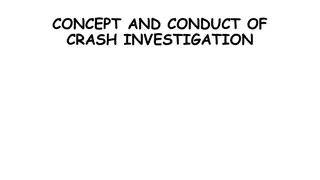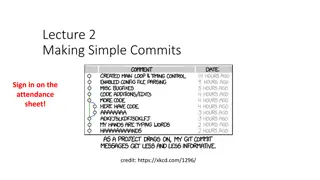
Understanding Version Control Systems with Git
Explore the world of version control systems with a focus on Git. Learn why version control is essential, the different types of systems available, and dive into the basics of Git workflow. Get started with setting up Git and creating new repositories to manage your project efficiently.
Download Presentation

Please find below an Image/Link to download the presentation.
The content on the website is provided AS IS for your information and personal use only. It may not be sold, licensed, or shared on other websites without obtaining consent from the author. If you encounter any issues during the download, it is possible that the publisher has removed the file from their server.
You are allowed to download the files provided on this website for personal or commercial use, subject to the condition that they are used lawfully. All files are the property of their respective owners.
The content on the website is provided AS IS for your information and personal use only. It may not be sold, licensed, or shared on other websites without obtaining consent from the author.
E N D
Presentation Transcript
An introduction to version control systems with Git
Version control systems Version control systems record changes to a file or set of files over time so that you can recall specific versions later Many systems have risen to popularity over the years RCS CVS Subversion We will focus on Git 2
Why use version control? These systems help with: Tracking changes Short and long term undo Backup and restore Synchronization Collaboration 3
The basic Git workflow Modify files in your working directory Stage the files, adding snapshots to your staging area Commit your changes to your local copy of the repository 7
The lifecycle of a file in Git Git does not necessary keep track of all files in your working directory 8
Gitting started Set your identity $ git config --global user.name "John Doe" $ git config --global user.email jdoe@example.com Set other configuration options $ git config --global color.ui true Get help $ git help <verb> 10
Creating a new repository $ git init Creates a new (empty) repository in the current directory 11
Copying a repository For this class, your instructor will create a repository for you, you will just need to copy it from GitHub to your computer using the following command: $ git clone <repository> Creates a copy of <repository> in the current directory 12
Staging files As you work, you will create new files and modify existing files, when you are satisfied with your changes, you can stage them for commit with: $ git add <file_pattern> 13
Committing changes Commits create a new version in the repository Include a commit message describing the new version $ git commit -m <msg> 14
Checking working directory status $ git status Reports: Files in the working directory that are not tracked File modifications not yet staged for commit File additions and modifications staged for commit 15
Overviewing commit history $ git log Lists commits made to the current repository 16
Handy command - comparing versions It may be handy to see exactly how files changed $ git diff Shows modifications not yet staged for commit $ git diff <commit_id> Show changes since the commit specified $ git diff <commit_id1> <commit_id2> Show changes between two commits 18
What we've covered here... presents only a brief overview of Git Further topics: branching rebasing tagging Further resources: https://git-scm.com/book/en/v2 http://gitref.org/ http://gitimmersion.com/ 19






















